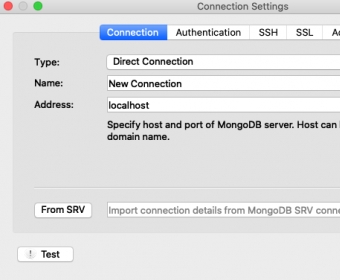

#Robo 3t download how to
Please continue reading as we show you how to install Robo3T on your system. We find Robo3T strongest feature is that it doesn’t hog your resources.
#Robo 3t download for mac os
There is a version of Robo3T for Mac OS X, Windows, and Linux systems. In the embedded shell Robo3T provides a great autocomplete feature which is invaluable for developers who jump back and forth between different languages and have a hard time remembering the exact syntax. Robo3T also provides an embedded shell so users can still use the MongoDB shell if necessary. Robo3T allows you to perform all of the primary functionality in a GUI without having to remember the MongoDB shell syntax. Robo3T is one of several GUI tools including Compass and Studio 3T that allow you to visualize your data which can be very hard to do through the MongoDB shell.

Next, select the 'Authentication' tab in the top bar of the open 'Connection Settings' window.Then, enter the server name into the 'Address' field, and port into the 'Port' field as found in your Connection String from the ScaleGrid MongoDB cluster details page:.Once the Connecting Settings window opens, select 'Direct Connection' as the 'Type'.Click on ‘Create’ underneath 'Manage Connections' to setup a new connection.Launch Robo 3T and open the ‘Manage Connections’ window.On the MongoDB web-shell, type in the create new user command as shown in the image above and below: You can use the ScaleGrid web-shell available on the Admin tab to create such a user: For this example, we will create a new user who has read-write access to any database on the cluster. Users created on the admin database with All-Database roles provide privileges which apply to all non-system databases of the deployment. Select the Users tab and click on the New User button:įill in the new user’s name and password, then select its role and click Create: Then, click on the Manage button beside the database you want to create the user on: In order to create simple, per-database, read-write or read-only users, log into the ScaleGrid console, navigate to the cluster details page, and click on the Databases tab. For more detailed instructions, visit this doc: Let's walk through two examples of creating MongoDB users from the ScaleGrid console. We do not recommend connecting to your MongoDB deployment using the “admin” user that ScaleGrid provides by default. The roles that you choose to assign to the user will depend on your exact use-case. PostgreSQL Follower Clusters - Scheduled SyncĬreate a new user with appropriate permissions for client access.Export a PostgreSQL Database Hosted on ScaleGrid.Import a PostgreSQL Database Using Command Line Tools.Importing PostgreSQL Data From a Remote Server.PostgreSQL Peek at Backup/Selective Restores.Get The Hostname of Your PostgreSQL Deployment.New PostgreSQL Deployment: Dedicated Hosting.New PostgreSQL Deployment: Bring Your Own Cloud.MySQL Follower Clusters - Scheduled Sync.Export a MySQL Database Hosted on ScaleGrid.Import a MySQL Database Using Command Line Tools.Importing MySQL Data From a Remote Server.MySQL Selective Restores/Peek at Backup.Zapier - Creating new Google Sheets rows from MySQL rows.Zapier - Creating new MySQL rows from Google Sheets rows.Get The Hostname of Your MySQL Deployment.New MySQL Deployment: Bring Your Own Cloud.New MySQL Deployment: Dedicated Hosting.Scale MongoDB Standalone to Replica Set.MongoDB Follower Clusters - Scheduled Sync.Import MongoDB Data From an Existing ScaleGrid Cluster.Import MongoDB Data From a Remote Server.New MongoDB Cluster: Bring Your Own Cloud.


 0 kommentar(er)
0 kommentar(er)
